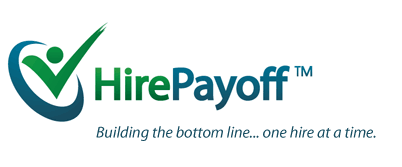“Research shows ‘Can Do’ qualities outpace ‘Will Do’ ones not only in predicting new hire performance, but in reducing their turnover,” says Dr. David Jones
October 7, 2014 – “We’ve explained in many prior releases how important it is to gain a view of ‘the whole candidate’,” says Dr. David Jones. “We’ve drawn on data analytics to learn just how well-measured ‘Can Do’ and ‘Will Do’ qualities link together to drive job performance. A recent assignment added yet another finding – ‘Can Do’ qualities reduce turnover among new hires, a major payoff in today’s world of growing worker turnover,” adds Jones.
In a recent release (‘Can Do’ Gets Things Started, But ‘Will Do’ Keeps Them Rolling), the HirePayoff™ team described working with a distribution center employer spread across the U.S. to implement the HirePayoff™ employment testing tool. The goal – find new hires who hit the company’s productivity standards; a metric tracked electronically and used to frame employee pay.
“When we implemented and set standards on the HirePayoff™ tool after assessing a large group of current employees, both ‘Can Do’ and ‘Will Do’ scores predicted on-the-job productivity,” reports Jones. “Surprising, though, was the fact that ‘Will Do’ scores carried nearly twice the weight of ‘Can Do’ scores in predicting productivity. The ‘Will Do’ qualities drive to succeed and eager to engage really shaped productivity. We were surprised at the much weaker role played by scores on the test’s ‘Can Do’ competencies,” Jones adds.
“After the employer screened and hired more than 200 new workers, and then used the HirePayoff™ New Hire Performance Check-Up to collect information about their initial job performance, new hires’ test scores showed a significant relationship with initial on-the-job performance; solid evidence of test validity,” says Rand Gottschalk, HirePayoff™ Chief Operating Officer. “But now, things were different… new hires’ ‘Can Do’ competencies far outweighed ‘Will Do’ ones in predicting new hires’ initial job performance,” Gottschalk adds.
As Jones pointed out in an earlier release, “It makes sense. A new hire needs to learn the job, shape what they do, how they do it, and learn behaviors that raise productivity. ‘Can Do’ competencies shape these results. Later, once the job is learned, ‘Will Do’ competencies take over. Lots of us have believed this, but the data analytics from the two projects made it so very clear,” said Jones.
Turn the calendar page ahead another year. Launch another Six Sigma continuous improvement. Look at more than 400 additional new employees’ HirePayoffTM ‘Can Do’ and ‘Will Do’ scores, along with their New Hire Performance Check-Up results. The focus – explore whether ‘raising the bar’ on the test’s qualifying standard might identify even more effective new hires. After data analytics, the recommendation – raise the test standard just over five percent to gain an 11 percent increase in New Hire Performance Check-Up ratings.
“We went further in gauging the payoff of the new test standard, though,” says Jones. “We looked at a growing problem in the U.S. workplace – turnover. We assembled data on ‘involuntary turnover’ rates among the year’s more than 400 hires. About half of all turnover, these releases were made by the employer, not employees, as a result of some new hires just not hitting expectations,” adds Jones.
“The result was really noteworthy,” says Gottschalk. “Not only would the new test standard improve performance ratings by 11 percent, it would reduce the rate of involuntary turnover among new hires by more than one-half. In effect, ‘raising the bar’ would not only improve the performance of those hired, it would reduce the number of hires needed, since far lower involuntary turnover would follow,” adds
Gottschalk.
“Again, too, it was candidate ‘Can Do’ qualities that carried most all the weight in forecasting short-term involuntary turnover,” says Jones. The ‘Will Do’ assessment data played only a minor role in forecasting this short-term turnover. “Makes sense,” says Jones, “it’s new hire learning and performance that drives an employer’s involuntary turnover decisions.
In summary, the initial objective was to improve new hire performance with the HirePayoff™ tool. Using the program’s continuous improvement model, though, attention was put on the cost of turnover, as well. “Less turnover means less hiring. Less hiring means less investment in recruiting, candidate screening, training, and employee release. Why not shoot for both?” says Jones.
“One more thing,” says Gottschalk. “Every employer today knows avoiding adverse impact and employment discrimination in a hiring process is a concern. Here, as in the employer’s prior years of continuous improvement studies, a review of candidates’ scores on the HirePayoff™ test showed not only that the scores predicted new hire performance and turnover, but that there were no differences between the scores achieved by white, African American, Hispanic, male, or female candidates, yielding diversity in hiring,” adds Gottschalk.
About HirePayoff™
David Jones, PhD, author of Million-Dollar Hire: Building Your Bottom Line, One Employee at a Time, published in April, 2011 by Jossey-Bass, is among the few HR professionals to found and grow a major international HR consulting business. In Million-Dollar Hire he shows how, even in a slow economy, U.S. employers make millions of hiring decisions every month. Every decision carries risk. Every hire is an investment. Ideally, every hiring decision pays a return. Using practical, real world illustrations, Jones shows there are tools to treat every hiring decision with the same focus a business applies in acquiring other high-value assets.
Today, Jones is president of Growth Ventures Inc., whose HirePayoff™ division works with employers to implement ‘Can Do’ and ‘Will Do’ online employee testing. Through HirePayoff™, Jones helps companies re-invent their recruitment and selection practices and add to the bottom line with re-engineered, legally compliant tools. For more information, visit www.hirepayoff.com.
Media Contact:
Dr. David Jones
President & CEO
HirePayoff™
231-675-1500
davejones@hirepayoff.com
